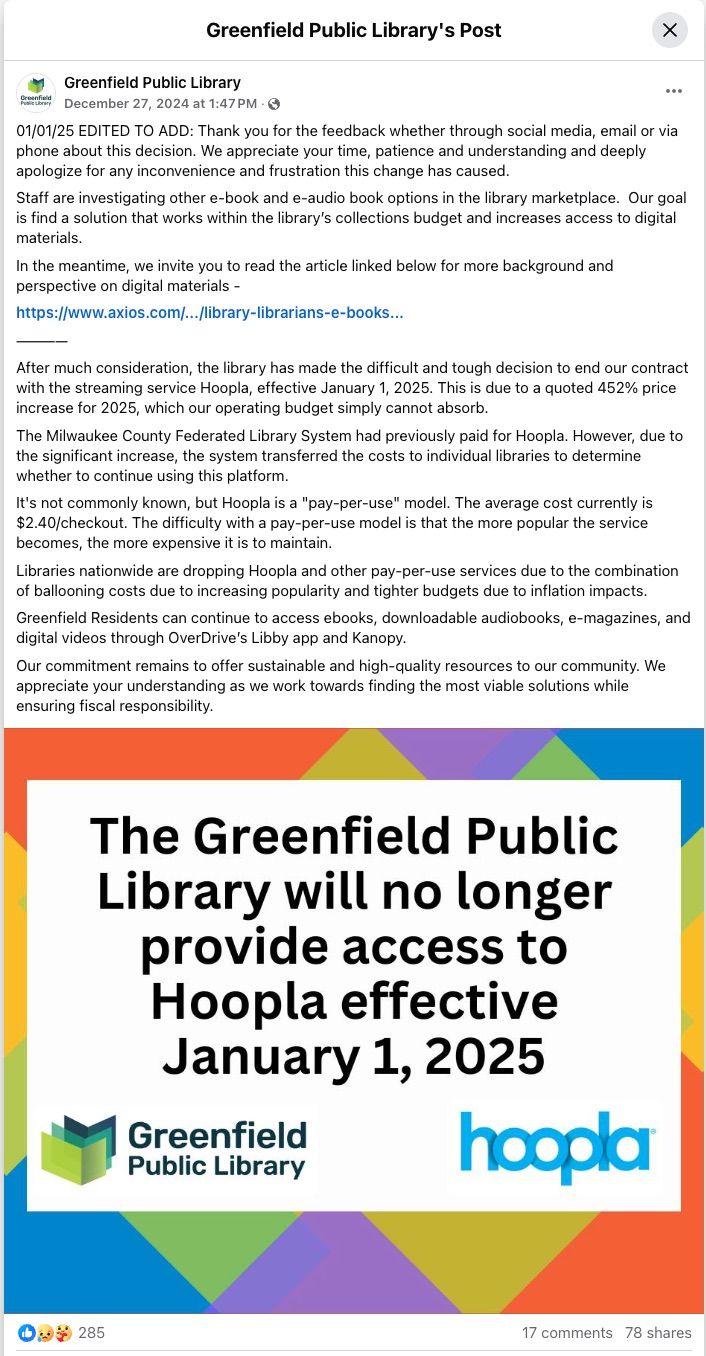Public libraries provide access to materials. Over the last couple of decades, this has meant increasing the opportunities to access digital content. Being able to grab your next favorite read, your next favorite listen, or your next favorite film has become much easier thanks to streaming providers that public libraries contract with, including Midwest Tape’s hoopla product. Hoopla serves as the access point between local libraries and the digital material creators—in other words, hoopla works with audiobook, ebook, and digital video owners in negotiating rights and costs, and then hoopla hosts those materials on their platform, which they then contract out with libraries.
The exorbitant costs of ebooks for libraries have been written about for the last several years. This includes an outstanding cost breakdown by librarian Jennie Rothschild over at Smart Bitches, Trashy Books, in August of 2020. The timing of that piece isn’t coincidental. Thanks to the pandemic, more and more people turned to the digital offerings of their local libraries to stay entertained, to stay informed, and to stay connected to their libraries when it may not have been safe to go in person.
Usage of digital materials in public libraries continues to skyrocket. A report from 2023 notes a 34% increase in digital book use at libraries since just 2019, while other libraries have reported even higher increases in their digital collection use. Woodstock Public Library (IL), my local library, provided data that specifically shows increased use of hoopla. In 2023, patrons borrowed 6,402 digital items and in 2024, they borrowed 9,213, an increase of nearly 40%. Among the most borrowed hoopla items were audiobooks (from 3,498 to 5,427), movies (from 406 to 681), ebooks (from 1,708 to 2,121), and comics (from 266 to 359).
Despite demonstrated increases in use of digital materials, most libraries have not seen an increase in their annual budgets. In 2023 that at least one library talked about the need to close three branches of their system in large part thanks to increasing costs of digital materials (the libraries would remain open, as this was not the primary thrust behind the attempted closures).
There are several ways that libraries provide this content, with the biggest vendors being OverDrive (and its app Libby), Kanopy, and Midwest Tape/hoopla. Each operates a little bit differently. OverdDrive/Libby operates most like you’d expect of a traditional library, giving control of what content is available and in what quantity to the library or the consortium of libraries of which an individual library is a part. OverDrive/Libby has an array of formats available to purchase, though most libraries focus their collections on ebooks and digital audiobooks with this vendor. That’s because they frequently supplement their OverDrive/Libby offerings with a subscription to Kanopy, a streaming service with on-demand access to movies and television. Midwest Tape’s hoopla seeks to be a bridge between the two, offering ebooks, as well as comics, TV shows, movies, and audiobooks. While OverDrive/Libby has a much more robust offering of items than hoopla in terms of ebooks, hoopla provides a lot of value in that its materials are available instantly. It is worth noting here that hoopla has been criticized for several years because their service has pushed mis- and dis- information in its material offerings, including unvetted and harmful materials that no library would approve for their physical collections.
With OverDrive/Libby, libraries purchase a specific number of licenses for materials available to their patrons (in other cases, they purchase a license good for a specific span of time, like 24 months). They might buy one ebook copy of a particular title, and anyone who wants to borrow it must put a hold on it if it’s in use. As noted in the above-linked cost breakdown of ebooks, libraries often need to repurchase those licenses once the item has been borrowed a certain number of times. This means that the ebook the library has already paid more money for than the average consumer must be repurchased to continue being available.
Hoopla, on the other hand, operates on a pay-per-use model. They make materials in their catalog available instantly and simultaneously so that there is no waiting on the part of the patron. If you want to borrow an item in hoopla’s catalog, you can, even if it is being used by several other patrons. In many ways, this is an excellent way to serve the needs of users. But because hoopla’s model is pay-per-use, the library is paying for each and every one of those uses as they happen. It’s not a set price for a set number of uses.
On the library user side of things, that means you most likely wouldn’t be able to borrow Onyx Storm right now via Libby because of how popular the title is. You’d be on a waitlist for several weeks, if not months, as other patrons use the item before you. You may, however, be able to access Onyx Storm instantly, right now, on hoopla if you are not at your borrowing limit. But each person accessing a title simultaneously means that the library is paying for each of those uses without a clear picture of how many people in total want the item now and six months from now.
That last piece is important as we talk about the costs associated with hoopla. With stable, if not decreasing, public library budgets and an increase in demand for digital materials, libraries are between a rock and a hard place. They don’t want to create barriers to access for their patrons, especially as use of digital materials—and thus demonstrated interest and demand—continues to increase.
One imperfect way libraries have dealt with this is by limiting the number of items a single person can borrow from hoopla at once. West Allis Public Library in suburban Milwaukee, Wisconsin, chose to do what others nationwide have done and limit the number of items patrons can borrow per month, lowering it from four to two.
The other, even crummier option public libraries are finding necessary?
Ditch hoopla all together.
 |
Suburban Milwaukee’s Greenfield Public Library announced at the end of December 2024 that they would be dropping hoopla from their offerings. This was largely because the Milwaukee County Federated Library System—a larger system with a bigger budget that helped support hoopla access to neighboring suburban libraries—was no longer going to be able to float the costs. There were too many patrons wanting access and each instance of borrowing an item hit Milwaukee library’s budget. This was despite libraries within the system, like West Allis, metering how many items patrons could access per month.
Now those smaller libraries are in a tough spot. The pay-per-use model means their budgets will skyrocket by offering hoopla’s services. Where these libraries did not pay for hoopla before, they now face the reality of paying not an average of $2.40 per checkout as it was in 2024. They’ve been quoted a new cost from hoopla for 2025 that is an over 450% increase, or about $11 per item. A single patron borrowing 10 items at a time would cost the library $24 in 2024. In 2025, that would cost the library $110.
The catch is, of course, that libraries cannot estimate how many patrons will use the service in any given month and, therefore, cannot adequately budget for that access. This is one point in favor of a metered system, as it can provide a high-end estimate for monthly costs associated with hoopla—you know how many patrons your library has using the resource and you know they are limited to two items per month, so you can safely estimate that month’s costs.
Despite the loss of an entire platform through which patrons can access digital materials, responses to Greenfield Public Library’s post are supportive of the move. Patrons note that they not only understand the sticker shock of such an increase but that they still have access to OverDrive/Libby and Kanopy through the library. Their choices have decreased, but so, too, do they understand the tax money they’re paying to help acquire digital materials can only go so far.
Over the next year, we’re going to see this happen in library after library. What is difficult to understand, though, is that costs associated with digital materials are not increasing at the rate of 450% each year. Perhaps the thinking here is that because public libraries already pay an outsized fee for ebooks and digital audiobooks, increasing the price per use on hoopla would go unnoticed or wouldn’t feel outsized, given that libraries also pay to renew licenses for individual items via OverDrive/Libby.
It’s also a reminder that libraries do the difficult job of not only negotiating with businesses to provide material to their patrons but libraries are also then are subject to the decisions of those businesses, including sometimes angry or frustrated reactions from patrons who see the services they appreciated change.
Hoopla, knowing how popular their service was, saw an opportunity to increase prices while keeping their services and offerings the same (they did, however, find time in 2024 to try to implement a dangerous book rating that mirrored one created by Moms For Liberty and undermined the expertise of the very librarians for whom they seek business; the company ultimately backtracked when confronted). The library does not want to pass those increased costs along to their consumers, and sometimes, that means making the decision to best steward public funds by canceling contracts with vendors who do not understand their core market.
Libraries, whether public, school, or academic, won’t stop providing digital resources, just as they won’t get rid of physical books or media. But, like it is crucial to understand that libraries are being unfairly charged for ebooks compared to the average consumer, it is also vital to know that content providers like hoopla are making it more and more difficult to meet increased patron interest. If you love what your library offers, it’s important not only to tell them but to also advocate on their behalf.
Source : Your Library’s Hoopla Digital Collections Are Breaking Their Budget









